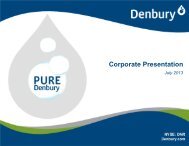Interactive 2009 Annual Report (PDF 7.56 MB) - Denbury Resources ...
Interactive 2009 Annual Report (PDF 7.56 MB) - Denbury Resources ...
Interactive 2009 Annual Report (PDF 7.56 MB) - Denbury Resources ...
- No tags were found...
You also want an ePaper? Increase the reach of your titles
YUMPU automatically turns print PDFs into web optimized ePapers that Google loves.
<strong>Denbury</strong> <strong>Resources</strong> Inc. <strong>2009</strong> <strong>Annual</strong> <strong>Report</strong> 13work was completed and CO 2 injection started during the first quarter of 2006. Initial tertiary oil production occurred inthe fourth quarter of 2006. During <strong>2009</strong>, we developed the remaining injection patterns in the field, and expandedthe CO 2 facility. Oil production continued to increase as the Eutaw Reservoir was more fully developed, averaging 3,912Bbls/d during the fourth quarter of <strong>2009</strong>. We anticipate that production from this field has peaked, or is about to peak,as the field is generally fully developed. With the completion of the majority of the field development, our 2010 plans willconsist of expanded fluid handling capabilities at the central facility and monitoring compression requirements.From inception through December 31, <strong>2009</strong>, we had net positive cash flow (revenue less operating expenses andcapital expenditures, including the acquisition cost) from Eucutta of $71.2 million.Soso Field. Soso Field, near Laurel, Mississippi, produced from numerous reservoirs during primary productionincluding the Rodessa, Bailey and Cotton Valley sands, all of which we plan to CO 2 flood. We elected to co-develop theBailey sand and Rodessa sand to accelerate the development of the potential tertiary oil reserves at Soso. In essence,we will flood the Bailey in one portion of the field and the Rodessa in the other, with plans to switch formations wheneach is depleted. During the first quarter 2006, we initiated our first injections of CO 2 into five Bailey injection wells andinitiated injection in the Rodessa during the second quarter of 2006. We saw our first tertiary production in early 2007from the Bailey and our first response from the Rodessa in the fourth quarter of 2007.We made significant additions to the CO 2 recycle facility during <strong>2009</strong>, increasing the water separation and handling.Once fluid handling capabilities were addressed, several jet pumps were installed which assisted in lifting the waterin the wellbore and subsequently increased oil production. The installation of jet pumps is temporary in that as soonas the well begins producing oil, we are able to recover the pump and install the pump in another well if necessary.During the fourth quarter of <strong>2009</strong>, production at Soso had increased to 3,224 Bbls/d. Additional compression andhandling of recycled CO 2 will be addressed during 2010, along with four workovers and/or recompletions to addanother injection pattern.From inception through December 31, <strong>2009</strong>, we had not yet recovered our costs in this field with net negative cash flow(revenue less operating expenses and capital expenditures, including the acquisition cost) from Soso of $28.2 million.Martinville Field. We initiated our first injections of CO 2 in Martinville Field during the first quarter of 2006 in both theRodessa and Mooringsport formations. As is the case with most of the East Mississippi fields, Martinville producesfrom multiple reservoirs. Unlike the majority of our other planned CO 2 projects, Martinville does not contain a singlelarge reservoir to CO 2 flood, but rather several smaller reservoirs. We completed construction of the CO 2 facilities andcompleted the development of the Mooringsport formation during 2006. During 2008, an additional producing well wasdrilled to expand the development of the Rodessa sand. A Lower Hosston “huff and puff” project was also initiated.The Lower Hosston project consists of injecting a predetermined volume of CO 2 into the reservoir, allowing the CO 2time to disperse and contact oil, then flowing the well back and producing the oil that contacted the CO 2 . Weexperienced operational difficulties in producing the first cycle of this “huff and puff” test during <strong>2009</strong> and moveduphole to another Hosston interval. Early in 2010, we started the production cycle from this interval and its preliminaryresults are promising.During the fourth quarter of <strong>2009</strong>, production at Martinville averaged 724 Bbls/d, almost all of which is from theMooringsport. To date, we have booked additional proved reserves in the Mooringsport, Rodessa IX and a smallamount in the Wash-Fred reservoirs. There are several additional Rodessa reservoirs that will be developed followingcompletion of the CO 2 flood in the Rodessa IX. From inception through December 31, <strong>2009</strong>, we had not yet recoveredour costs in this field with net negative cash flow (revenue less operating expenses and capital expenditures, includingthe acquisition cost) from Martinville of $2.6 million.The Martinville Field Wash Fred 8500’ reservoir development continues to evolve. The Wash Fred formation containsa low oil gravity (thick oil), 15o API, which will not develop miscibility with CO 2 at reservoir conditions. <strong>Denbury</strong> hasseveral fields with similar low gravity oils, which like the Wash Fred 8500’ have had lower recoveries due to the low oilgravities and strong water drives, which do not sweep the oil efficiently. We have experimented with this reservoir since2006 but have not had much success until recently, when an offset producing well began to produce oil during <strong>2009</strong>.Form 10-K Part I




